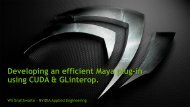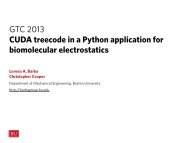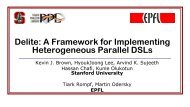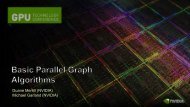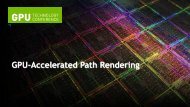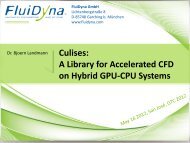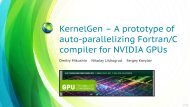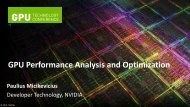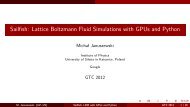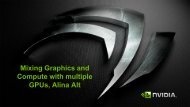Instruction Throughput - GPU Technology Conference
Instruction Throughput - GPU Technology Conference
Instruction Throughput - GPU Technology Conference
You also want an ePaper? Increase the reach of your titles
YUMPU automatically turns print PDFs into web optimized ePapers that Google loves.
<strong>Instruction</strong> Limited Kernels<br />
CUDA Optimization Webinar<br />
Gernot Ziegler,<br />
Developer <strong>Technology</strong> (Compute)<br />
© NVIDIA Corporation 2011
Analysis-Driven Optimization<br />
• Determine the limits for kernel performance<br />
• Memory throughput<br />
• <strong>Instruction</strong> throughput<br />
• Latency<br />
• Combination of the above<br />
• Use appropriate performance metric for each kernel<br />
• For example, for a memory bandwidth-bound kernel, Gflops/s don‟t make sense<br />
• Address the limiters in the order of importance<br />
• Determine how close resource usage is to the HW limits<br />
• Analyze for possible inefficiencies<br />
• Apply optimizations<br />
- Often these will just be obvious from how HW operates<br />
© NVIDIA Corporation 2011<br />
2
Presentation Outline<br />
• Identifying performance limiters<br />
• Analyzing and optimizing :<br />
• Memory-bound kernels (Oct 11th, Tim Schroeder)<br />
• <strong>Instruction</strong> (math) bound kernels<br />
• Kernels with poor latency hiding<br />
• Register spilling (Oct 4th, Paulius Micikevicius)<br />
• For each:<br />
• Brief background<br />
• How to analyze<br />
• How to judge whether particular issue is problematic<br />
• How to optimize<br />
• Some cases studies based on “real-life” application kernels<br />
• Most information is for Fermi <strong>GPU</strong>s<br />
© NVIDIA Corporation 2011<br />
3
Notes on profiler<br />
• Most counters are reported per Streaming Multiprocessor (SM)<br />
• Not entire <strong>GPU</strong><br />
• Exceptions: L2 and DRAM counters<br />
• A single run can only collect a few counters<br />
• Multiple runs are needed when profiling more counters<br />
- Done automatically by the Visual Profiler<br />
- Have to be done manually using command-line profiler<br />
- Use CUPTI API to have your application collect signals on its own<br />
• Counter values may not be exactly the same for repeated runs<br />
• Threadblocks and warps are scheduled at run-time<br />
• So, “two counters being equal” usually means “two counters within a small delta”<br />
• See the profiler documentation for more information<br />
© NVIDIA Corporation 2011<br />
4
Limited by Bandwidth or Arithmetic?<br />
• Perfect fp32 instructions:bytes ratio for Fermi C2050:<br />
• ~4.5 : 1 instructions/byte with ECC on<br />
• ~3.6 : 1 instructions/byte with ECC off<br />
• These assume fp32 instructions, throughput for other instructions varies<br />
• Algorithmic analysis:<br />
• Rough estimate of arithmetic to bytes ratio<br />
• Actual Code likely uses more instructions and bytes<br />
than algorithmic analysis suggests:<br />
• <strong>Instruction</strong>s for loop control, pointer math, etc.<br />
• Address pattern may result in more memory transactions/bandwidth<br />
• Two ways to investigate:<br />
- Use the profiler (quick, but approximate)<br />
- Use source code modification (more accurate, more work intensive)<br />
© NVIDIA Corporation 2011<br />
5
CUDA 4.0: Visual Profiler Optimization Hints<br />
• Visual Profiler gathers hardware signals<br />
via command-line profiler<br />
• Profiler computes derived values:<br />
• <strong>Instruction</strong> throughput<br />
• Memory throughput<br />
• <strong>GPU</strong> Occupancy<br />
(Computation detailed in documentation)<br />
• Using these derived values,<br />
profiler hints at limiting factors<br />
This talk shows the thoughts<br />
behind Profiler hints, but<br />
also how to interpret <strong>GPU</strong> profiler signals<br />
while doing your own experiments, e.g.<br />
through source-code modifications<br />
© NVIDIA Corporation 2011
Optimizations for <strong>Instruction</strong> <strong>Throughput</strong><br />
© NVIDIA Corporation 2011<br />
7
Possible Limiting Factors<br />
• Raw instruction throughput<br />
• Know the kernel instruction mix<br />
• fp32, fp64, int, mem, transcendentals have different throughputs<br />
- Refer to the CUDA Programming Guide / Best Practices Guide<br />
• Can examine assembly, if needed:<br />
- Can look at PTX (virtual assembly), though it‟s not the final optimized code<br />
- Can look at post-optimization machine assembly (--dump-sass, via cuobjdump)<br />
• <strong>Instruction</strong> serialization ("instruction replays" for warp's threads)<br />
• Occurs when threads in a warp execute/issue the same instruction<br />
after each other instead of in parallel<br />
- Think of it as “replaying” the same instruction for different threads in a warp<br />
• Some causes:<br />
- Shared memory bank conflicts<br />
- Constant memory bank conflicts<br />
© NVIDIA Corporation 2011<br />
8
<strong>Instruction</strong> <strong>Throughput</strong>: Analysis<br />
• Profiler counters (both incremented by 1 per warp):<br />
• instructions executed: counts instructions encountered during execution<br />
• instructions issued: also includes additional issues due to serialization<br />
• Difference between the two: instruction issues that happened due to<br />
serialization, instruction cache misses, etc.<br />
- Will rarely be 0, concern only if it‟s a significant percentage of instructions issued<br />
• Compare achieved throughput to HW capabilities<br />
• Peak instruction throughput is documented in the Programming Guide<br />
• Profiler also reports throughput:<br />
- GT200: as a fraction of theoretical peak for fp32 instructions<br />
- Fermi: as IPC (instructions per clock).<br />
Note that theoretical maximum depends on instruction mix:<br />
e.g. fp32 only: IPC of 2.0 possible; fp64 instructions: IPC of 1.0 possible<br />
© NVIDIA Corporation 2011<br />
9
<strong>Instruction</strong> <strong>Throughput</strong>: Optimization<br />
• Use intrinsics where possible ( __sin(), __sincos(), __exp(), etc.)<br />
• Available for a number of math.h functions<br />
• 2-3 bits lower precision, much higher throughput<br />
- Refer to the CUDA Programming Guide for details<br />
• Often a single instruction, whereas a non-intrinsic is a SW sequence<br />
• Additional compiler flags that also help (select GT200-level precision):<br />
• -ftz=true : flush denormals to 0<br />
• -prec-div=false : faster fp division instruction sequence (some precision loss)<br />
• -prec-sqrt=false : faster fp sqrt instruction sequence (some precision loss)<br />
• Make sure you do fp64 arithmetic only where you mean it:<br />
• fp64 throughput is lower than fp32<br />
• fp literals without an “f” suffix ( 34.7 ) are interpreted as fp64 per C standard<br />
© NVIDIA Corporation 2011<br />
10
Serialization: Profiler Analysis<br />
• Serialization is significant if<br />
• instructions_issued is significantly higher than instructions_executed<br />
• CUDA 4.0 Profiler: <strong>Instruction</strong>s replayed %<br />
• Warp divergence (Warp has to execute both branch of if() )<br />
• Profiler counters: divergent_branch, branch<br />
Profiler derived: Divergent branches (%)).<br />
• However, only counts the branch instructions, not the rest of divergent instructions.<br />
• Better: „threads instruction executed‟ counter:<br />
Increments for every instruction by number of threads that executed the instruction.<br />
• If there is no divergence, then for every instruction it should increment by 32<br />
(and threads_instruction_executed = 32* instruction_executed)<br />
• Thus: Control_flow_divergence% =<br />
100 * ((32 * instructions executed) – threads instruction executed)/(32* instructions executed)<br />
© NVIDIA Corporation 2011<br />
11
Serialization: Profiler Analysis<br />
• SMEM bank conflicts<br />
• Profiler counters:<br />
- l1_shared_bank_conflict<br />
- incremented by 1 per warp for each replay<br />
(or: each n-way shared bank conflict increments by n-1)<br />
- double increment for 64-bit accesses<br />
- shared_load, shared_store: incremented by 1 per warp per instruction<br />
• Bank conflicts are significant if both are true:<br />
- instruction throughput affects performance<br />
- l1_shared_bank_conflict is significant compared to instructions_issued:<br />
- Shared bank conflict replay (%) =<br />
100 * (l1_shared_bank_conflict)/instructions_issued<br />
- Shared memory bank conflict per shared memory instruction (%) =<br />
100 * (l1 shared bank conflict)/(shared load + shared store)<br />
© NVIDIA Corporation 2011<br />
12
Serialization: Analysis with Modified Code<br />
• Modify kernel code to assess performance improvement if<br />
serialization were removed<br />
• Helps decide whether optimizations are worth pursuing<br />
• Shared memory bank conflicts:<br />
• Change indexing to be either broadcasts or just threadIdx.x<br />
• Should also declare smem variables as volatile<br />
- Prevents compiler from “caching” values in registers<br />
• Warp divergence:<br />
• Change the if-condition to have all threads take the same path<br />
• Time both paths to see what each costs<br />
© NVIDIA Corporation 2011<br />
13
Serialization: Optimization<br />
• Shared memory bank conflicts:<br />
• Pad SMEM arrays<br />
- For example, when a warp accesses a 2D array‟s column<br />
- See CUDA Best Practices Guide, Transpose SDK whitepaper<br />
• Rearrange data in SMEM<br />
• Warp serialization:<br />
• Try grouping threads that take the same path into same warp<br />
- Rearrange the data, pre-process the data<br />
- Rearrange how threads index data (may affect memory perf)<br />
© NVIDIA Corporation 2011<br />
14
Case Study: SMEM Bank Conflicts<br />
• A different climate simulation code kernel, fp64<br />
• Profiler values:<br />
• <strong>Instruction</strong>s:<br />
- Executed / issued: 2,406,426 / 2,756,140<br />
- Difference: 349,714 (12.7% of instructions issued were “replays”)<br />
• GMEM:<br />
- Total load and store transactions: 170,263<br />
- Instr:byte ratio: 4<br />
- Suggests that instructions are a significant limiter<br />
(especially since there is a lot of fp64 math)<br />
• SMEM:<br />
- Load / store: 421,785 / 95,172<br />
- Bank conflict: 674,856 (really 337,428 because of double-counting for fp64)<br />
- This means a total of 854,385 SMEM access instructions<br />
(421,785 +95,172+337,428) , of which 39% replays<br />
• Solution: Pad shared memory array<br />
Performance increased by 15%<br />
- replayed instructions reduced down to 1%<br />
© NVIDIA Corporation 2011<br />
15
<strong>Instruction</strong> <strong>Throughput</strong>: Summary<br />
• Analyze:<br />
• Check achieved instruction throughput<br />
• Compare to HW peak (note: must take instruction mix into consideration)<br />
• Check percentage of instructions due to serialization<br />
• Optimizations:<br />
• Intrinsics, compiler options for expensive operations<br />
• Group threads that are likely to follow same execution path<br />
• Avoid SMEM bank conflicts (pad, rearrange data)<br />
© NVIDIA Corporation 2011<br />
16
Optimizations for Latency<br />
© NVIDIA Corporation 2011<br />
17
Latency: Analysis<br />
• Suspect latency issues if:<br />
• Neither memory nor instruction throughput rates are close to HW theoretical rates<br />
• Poor overlap between mem and math<br />
- Full-kernel time is significantly larger than max{mem-only, math-only}<br />
• Two possible causes:<br />
• Insufficient concurrent threads per multiprocessor to hide latency<br />
- Occupancy too low<br />
- Too few threads in kernel launch to load the <strong>GPU</strong><br />
- Indicator: elapsed time doesn‟t change if problem size is increased (and with<br />
it the number of blocks/threads)<br />
• Too few concurrent threadblocks per SM when using __syncthreads()<br />
- __syncthreads() can prevent overlap between math and mem within the same threadblock<br />
© NVIDIA Corporation 2011<br />
18
Simplified View of Latency and Syncs<br />
Memory-only time<br />
Math-only time<br />
Kernel where most math cannot be<br />
executed until all data is loaded by<br />
the threadblock<br />
Full-kernel time, one large threadblock per SM<br />
© NVIDIA Corporation 2011<br />
time<br />
19
Simplified View of Latency and Syncs<br />
Memory-only time<br />
Math-only time<br />
Kernel where most math cannot be<br />
executed until all data is loaded by<br />
the threadblock<br />
Full-kernel time, one large threadblock per SM<br />
Full-kernel time, two threadblocks per SM<br />
(each half the size of one large one)<br />
© NVIDIA Corporation 2011<br />
time<br />
20
Latency: Optimization<br />
• Insufficient threads or workload:<br />
• Best: Increase the level of parallelism (more threads)<br />
• Alternative: Process several output elements per thread – gives more independent<br />
memory and arithmetic instructions (which get pipelined) - downside: code complexity<br />
• Synchronization Barriers:<br />
• Can assess impact on perf by commenting out __syncthreads()<br />
- Incorrect result, but gives upper bound on improvement<br />
• Try running several smaller threadblocks<br />
- Less hogging of SMs; think of it as SM “pipelining” blocks<br />
- In some cases that costs extra bandwidth due to more halos<br />
• More information and tricks:<br />
• Vasily Volkov, GTC2010: “Better Performance at Lower Occupancy”<br />
http://www.gputechconf.com/page/gtc-on-demand.html#session2238<br />
© NVIDIA Corporation 2011<br />
21
Summary<br />
• Determining what limits your kernel most:<br />
• Arithmetic, memory bandwidth (Oct 11th), latency, register spilling (Oct 4th)<br />
• Address the bottlenecks in the order of importance<br />
• Analyze for inefficient use of hardware<br />
• Estimate the impact on overall performance<br />
• Optimize to use hardware most efficiently<br />
• More resources:<br />
• Profiler documentation! (Especially on derived profiler values)<br />
• Prior CUDA tutorials at Supercomputing<br />
- http://gpgpu.org/{sc2007,sc2008,sc2009,sc2010}<br />
• GTC2010 talks: http://www.nvidia.com/gtc2010-content<br />
• CUDA Programming Guide, CUDA Best Practices Guide<br />
© NVIDIA Corporation 2011<br />
22



